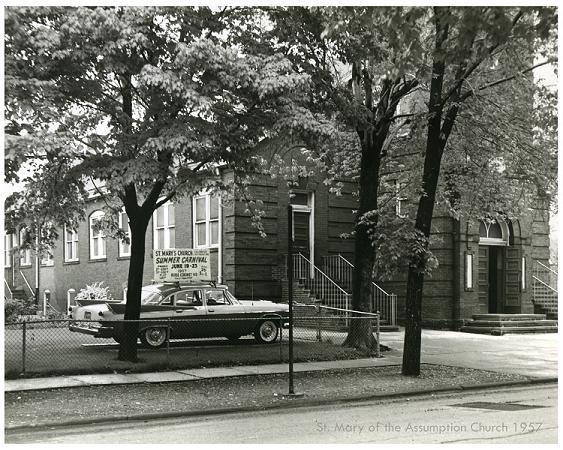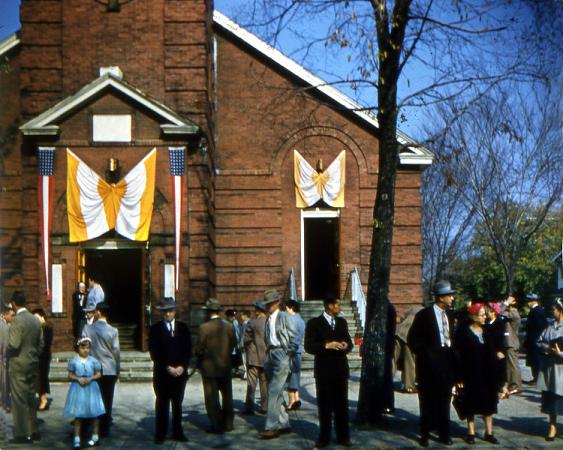
Church of Saint Mary of the Assumption
Established 1905
The road to find a permanent place of worship was a difficult one for early Slovenian settlers. A group of immigrants from Slovenia, an Alpine nation once part of the Austrian-Hungarian Empire, settled in the village of Collinwood, Ohio. They sought work in skilled trades, raised families and held true to their Catholic faith, but were outcast by other nationalities at the only Catholic church in the area, St. Joseph Church. They were sometimes restricted to the last pews in the church to worship and called “Greenhorns” or “Greiners” by people of other ethnic descents.
Early 1900s
In the early 1900s, things started to get better for the Slovenians of the area. A young priest from the Diocese of Marquette, Michigan came here to organize the Cleveland Slovenes. On November 10, 1905, Reverend Mark Pakiz held the first mass for the new congregation in his rented rooms on Collamer Street. He and his group then rented Saint Joseph Church for Sunday masses, but the $75 a month rent was too expensive for their meager earnings, so they rented space at Shephard’s Hall instead.

Soon the congregation, under the inspiration of Father Pakiz, pushed to build a church of their own, but debated over the location of the site. Collinwood was divided, north and south, by the Lake Shore and Michigan Southern Railroad. Those to the north of the railroad included 71 families and 89 single men. To the south were 59 families and 150 single men. At Shephard’s Hall on January 1, 1906, the debate was laid to rest when, by a majority vote, 152 members decided to build the church to the south of the railroad. In June 1906, they purchased five lots for $2000 on the corner of Case (now 156th Street) and Crosby (now Holmes Avenue).
Through the strong work ethic, dedication and enthusiasm of the Slovenian people, the dream of their own church became reality in 1906. Construction began in July of that year and the cornerstone was blessed by Bishop Ignatius Horstmann on September 17, 1906. Father Pakiz and his parishioners had their first mass on the 4th Sunday of Advent, 1906. The church was formally blessed on August 18, 1907. Cleveland Slovenians finally had a church to call home.
Through the years, St. Mary’s church experienced many hardships and tragedies. The first devastating event was the fire at Lakeview School (now Memorial School), where hundreds of children and teachers died on March 4, 1908. 40 were Slovenian children and 22 of them were St. Mary parishioners. Father Pakiz resigned that year for health reasons and was succeeded by Father Smrekar, who died of a throat ailment five years later. During Father Smrekar’s funeral, his manuscipts were stolen from the rectory. Father Paul Hribar took over the parish, but was sadly taken with his sister,Anna,when their car was struck on the tracks, October 18, 1917. The church lost an assistant pastor, Reverend Victor Virant, when he accidentally shot himself with a tear gas gun in 1936. On August 7, 1937, the Slovenian community suffered more despair at the death of Father Ludwig Kuznik and a young seminarian, Anthony Zorko, when they drowned while swimming in Lake Erie. Through the grief, the Slovenian parish stayed faithful and devoted to their God and community.
St. Mary’s church also saw growth and change during the years. By our 10th anniversary, the parish had 480 families and 2200 members. Father Paul Hribar established Saint Mary School in 1915 with 200 children attending religious instruction. The school was staffed by Ursuline Nuns. During the pastorate of Father Vitus Hribar, the Slovenian Choir, “Iliirija”, was founded under the direction of Martin Rakar in 1925 and a new parish house was built. A new brick school building was also erected in 1928. The Saturday Slovenian Language School was reopened for children ages Kindergarten to 8th grade in 1952 during the pastorate of Father Jager.
The biggest changes to St. Mary’s church also happened during Father Jager’s leadership with the building of a new church. He received permission from Archbishop Edward Hoban to build the new church and on October 21, 1956, ground-breaking took place next to the old church in conjunction with the 50th Anniversary celebration of the parish. The new church, which seated 850 people, was blessed during a Pontifical Mass celebrated by Archbishop Hoban, 30 priests and over 850 people. The cost of the new church was $722,186. The old church was turned into a Social Hall in 1957, when fire damaged the building.
The first American-born Slovenian priest to lead the church was Father Victor Tomc, who grew up in the area, served as an associate paster in the 1940s, returned as an associate in 1966 and took over leadership from Father Jager in 1967. During his pastorate, Father Tomc had the awesome responsibility of paying off the debt of the new church and carrying the parish through the changes of the Second Vatican Council. He also led the church through a changing urban scene that included closing factories, difficult economic times, the scattering of the Slovenian community to the suburbs and an aging neighborhood. He retired in 1987.
Our current pastor, Father John Kumse, took over on April 1, 1987 and has worked tirelessly and diligently to revive parish and community spirit, as well as to pay off all debts of the church. The church debts were paid in full in 2008 with a celebration of all parishioners. His guidence and leadership have brought renewed energy to the parish and a thriving church community focused on the needs of its parishioners.

